During the spring and summer seasons in Alberta, when the warblers make their arrival, one can commonly find yellow birds, but their numbers dwindle during the winter months. This comprehensive guide aims to assist you in identifying the yellow birds you spot in Alberta. It provides detailed descriptions, images, identification information, recorded songs, and migration patterns.
The majority of yellow birds found in Alberta are warblers, orioles, and tanagers. Additionally, there are instances where female birds exhibit strikingly different appearances compared to their male counterparts.
With the abundance of information provided in this guide, identifying yellow birds will become a much simpler task. The listed yellow birds are arranged according to their frequency of sightings in Alberta during the spring and summer months, as documented by ebird checklists for May and June.
Yellow birds present in Alberta throughout the year include the Evening Grosbeak. During the summer, various species can be observed, including the Yellow-rumped Warbler, Yellow Warbler, Cedar Waxwing, American Goldfinch, Yellow-headed Blackbird, Western Meadowlark, Common Yellowthroat, Orange-crowned Warbler, Baltimore Oriole, Wilson’s Warbler, American Redstart, Western Tanager, Western Kingbird, Magnolia Warbler, and Canada Warbler.
During migration periods, the Palm Warbler, Cape May Warbler, and Black-throated Green Warbler can be seen in Alberta.
Continue reading to effortlessly identify the yellow birds you’ve spotted, as the guide presents 19 different species of yellow birds found in Alberta.
1. Yellow-rumped Warbler

Yellow-rumped Warblers are frequently sighted in Alberta during the breeding season, which spans from mid-April to October. They are present in approximately 19% of summer checklists submitted by avid birdwatchers in the province.
These warblers possess a gray body with flashes of yellow on the face, sides, and rump, complemented by white wings. Female individuals may exhibit slight brown hues, while winter birds showcase paler brown tones with vibrant yellow rumps and sides, transitioning back to yellow and gray in spring.
Scientific Name: Setophaga coronata
Length: 4.7-5.5 inches (12-14 cm)
Weight: 0.4-0.5 ounces (12-13 g)
Wingspan: 7.5-9.1 inches (19-23 cm)
Yellow-rumped Warblers primarily breed in Canada, parts of the Rockies, and the Appalachian mountains. During migration, they can be spotted in the Midwest before settling in southern and southwestern US states, the Pacific Coast, Mexico, and Central America.
These warblers can be found in coniferous forests, especially during the breeding season. In winter, they tend to frequent open areas with fruiting shrubs. Their diet mainly consists of insects during summer and migration, while fruit, including bayberry and wax myrtle, becomes their primary food source in winter.
To attract Yellow-rumped Warblers to your backyard, provide them with sunflower seeds, suet, raisins, and peanut butter.
Fun Fact: Yellow-rumped Warblers tend to form flocks numbering in the thousands during winter and display aggression towards other bird species that venture too close.
2. Yellow Warbler
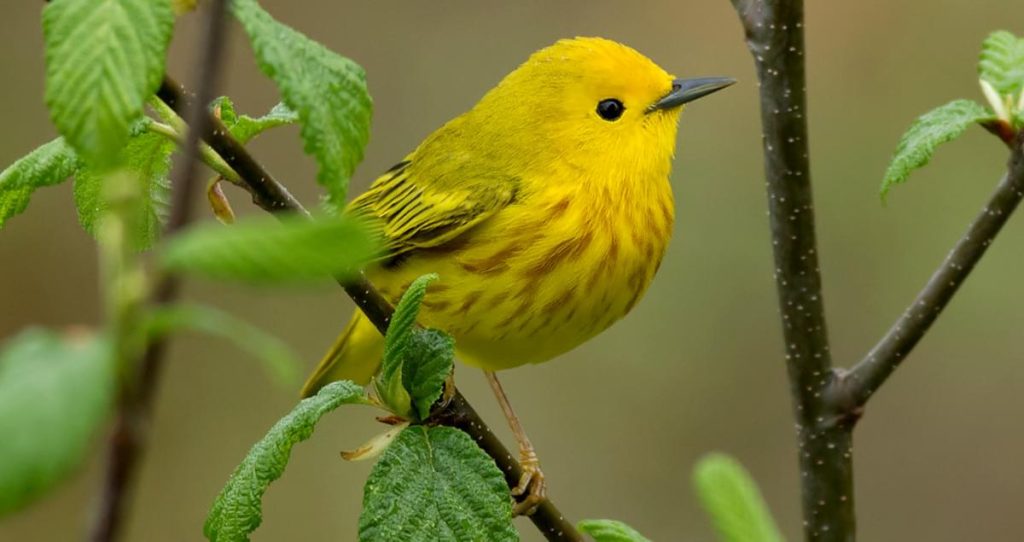
Yellow Warblers are the most commonly observed yellow birds in Alberta during the breeding season, occurring from May to September and appearing in approximately 26% of summer checklists.
These small, vibrant birds exhibit bright yellow plumage with a yellow-green back. Male individuals possess chestnut streaks on their breasts, while females and juveniles are not as strikingly colorful as the males.
Scientific Name: Setophaga petechia
Length: 4.7-5.1 inches (12-13 cm)
Weight: 0.3-0.4 ounces (9-11 g)
Wingspan: 6.3-7.9 inches (16-20 cm)
Yellow Warblers undertake long-distance migrations, traveling to Canada and the US, except for southeastern states, to breed. Subsequently, they head back to Central and South America for the winter. However, they can be observed during migration in southeastern US states.
These warblers can be found near streams, wetlands, thickets, and field edges, where they actively forage for insects such as caterpillars, midges, beetles, bugs, and wasps.
To attract Yellow Warblers to your backyard, offer suet, oranges, peanut butter, and plants that bear berries. Creating a welcoming environment with native plants that attract insects without the use of pesticides is highly recommended. Consider incorporating birdbaths with fountains near secluded plantings to provide additional protection.
Fun Fact: Yellow Warblers often encounter the parasitic behavior of cowbirds, which lay their eggs in the warblers’ nests. If detected, the Yellow Warblers build new nests on top of the old ones, repeating the process up to six times.
3. Cedar Waxwing
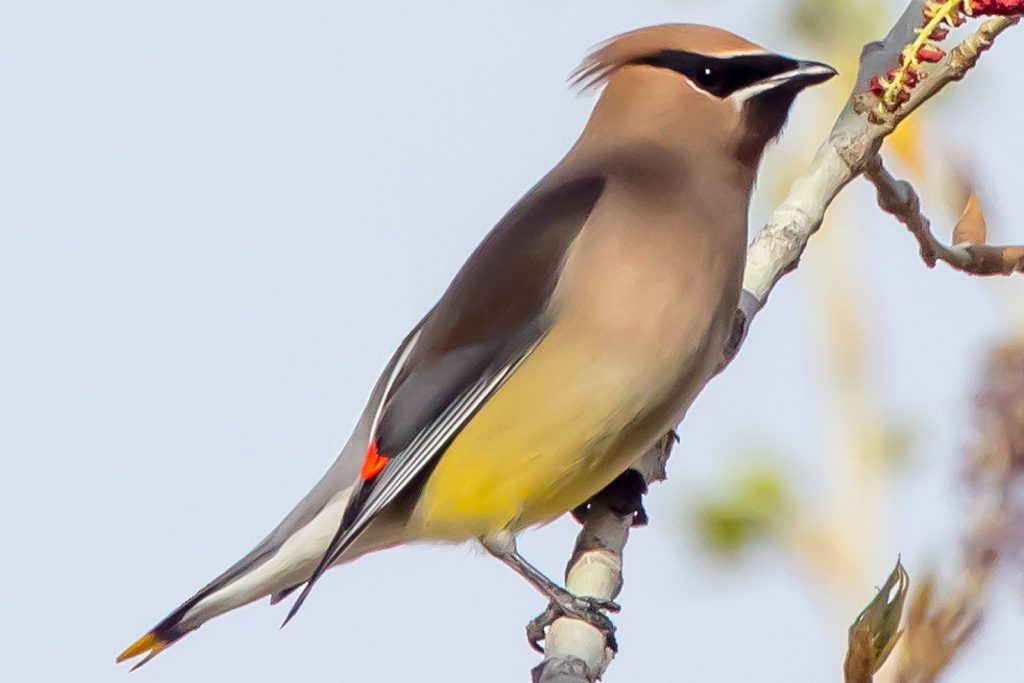
Cedar Waxwings are primarily sighted in Alberta during the breeding season, specifically from May to October. They are present in approximately 16% of summer checklists.
These elegant, sociable birds feature pale brown heads, chests, and crests that fade to gray on their backs, wings, and tails. Their bellies showcase a pale yellow hue, and their wings boast bright yellow tips. Notably, they possess a narrow black mask over their eyes and exhibit vibrant red accents on their wingtips.
Scientific Name: Bombycilla cedrorum
Length: 5.5-6.7 inches (14-17 cm)
Weight: 1.1 ounce (32 g)
Wingspan: 8.7-11.8 inches (22-30 cm)
Cedar Waxwings breed in Canada before embarking on migrations to the southern US, Mexico, and Central America for the winter. However, some populations remain resident year-round in northern US states.
These birds can be found in berry bushes, woodlands, grasslands, towns, and along streams. While they primarily feed on fruit, they also consume insects during the summer.
To attract Cedar Waxwings to your backyard, consider planting native trees and shrubs that bear small fruit, such as serviceberry, dogwood, juniper, winterberry, and hawthorn. Offering fruit on platform feeders can also entice these delightful birds.
Fun Fact: Cedar Waxwings engage in the act of gifting during courtship, passing objects between potential mates.
4. American Goldfinch
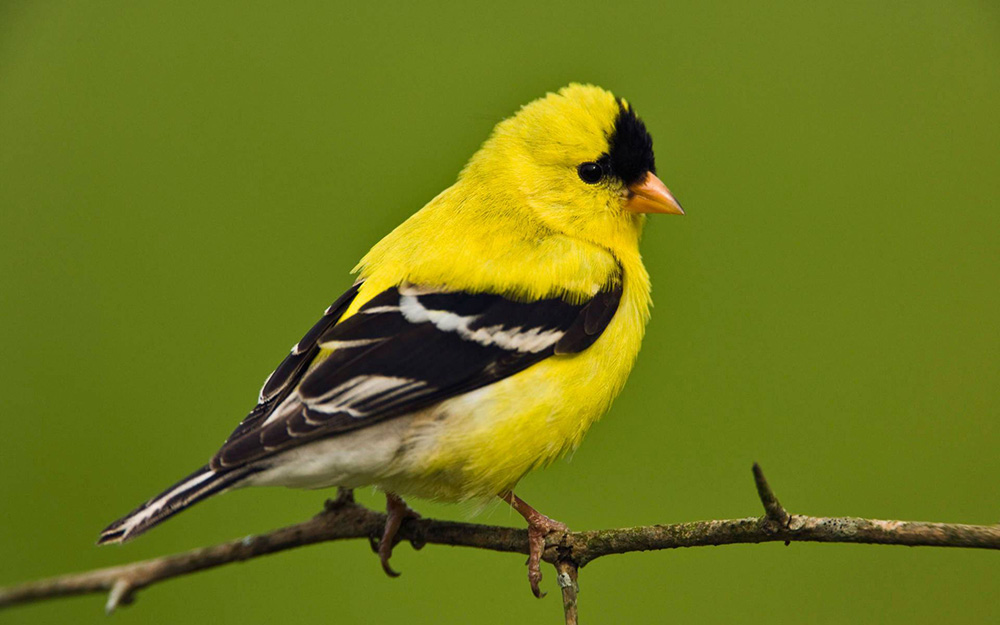
American Goldfinches are frequently observed in the southern regions of Alberta during the breeding season, spanning from May to November. They appear in approximately 14% of summer checklists.
These popular birds captivate bird enthusiasts, especially due to the striking, bright yellow and black coloring exhibited by males during spring. Females, as well as males during winter, showcase duller brown hues.
Scientific Name: Spinus tristis
Length: 4.3-5.1 inches (11-13 cm)
Weight: 0.4-0.7 ounces (11-20 g)
Wingspan: 7.5-8.7 inches (19-22 cm)
American Goldfinches can be found across most of North America and typically remain resident throughout the year. However, individuals that breed in Canada and the Midwest migrate to southern US states for the winter.
These goldfinches frequently forage for food in
weedy fields, overgrown areas, suburbs, parks, and backyards. Their diet consists mainly of sunflower and thistle seeds, and they readily visit various types of bird feeders.
Fun Fact: American Goldfinches possess a solely vegetarian diet, rendering them unattractive to cowbirds, whose young cannot thrive on such a diet.
5. Yellow-headed Blackbird
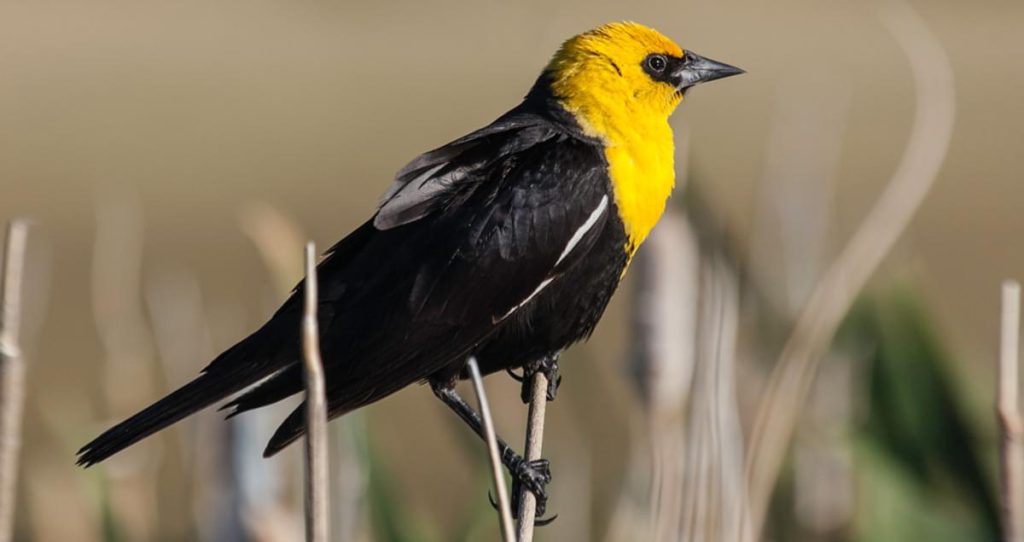
Yellow-headed Blackbirds are predominantly sighted in Alberta from mid-March to September, with some individuals remaining until December. They appear in approximately 12% of summer checklists.
These eye-catching birds boast glossy black bodies with vibrant yellow heads and chests. In males, white patches adorn the wings. Females, on the other hand, exhibit brown hues instead of black, with comparatively duller yellow heads. They are larger than Red-winged Blackbirds.
Scientific Name: Xanthocephalus xanthocephalus
Length: 8.3-10.2 inches (21-26 cm)
Weight: 1.6-3.5 ounces (44-100 g)
Wingspan: 16.5-17.3 inches (42-44 cm)
Yellow-headed Blackbirds breed in western and prairie wetlands, constructing their nests amidst the reeds. They forage over the surrounding wetlands, grasslands, and fields, primarily feeding on insects during the summer. Following the breeding season, they migrate to fields and farmlands in Southwest states and Mexico, forming large flocks for the winter.
These blackbirds display dietary versatility, consuming insects during summer and switching to seeds and grains during winter.
Fun Fact: Yellow-headed Blackbirds employ the technique of flipping over stones to flush out insects during their hunting endeavors.
6. Western Meadowlark

Western Meadowlarks can be spotted throughout the year in Alberta, with their prevalence being highest in the southern regions of the province from mid-March to October. They appear in approximately 10% of summer checklists.
With their bright yellow bellies and melodious songs, Western Meadowlarks bring joy to the surrounding environment.
These birds, part of the blackbird family, are approximately the size of a Robin. Their upperparts exhibit shades of brown and white, while a black V-shaped band adorns their bright yellow chests, transitioning to gray during winter.
Scientific Name: Sturnella neglecta
Length: 6.3-10.2 inches (16-26 cm)
Weight: 3.1-4.1 ounces (89-115 g)
Wingspan: 16.1 inches (41 cm)
Western Meadowlarks that breed in northern US states and Canada undertake migrations to more southern states for the winter. However, those residing in the western and midwestern regions remain in their habitats throughout the year.
These birds are commonly found on the ground in grasslands, meadows, and fields. They primarily forage for food alone or in small flocks, and their presence is less likely to be observed in wooded areas or dense shrubbery.
The diet of Western Meadowlarks consists of insects and seeds, with a preference for insects during summer and seeds and grains during winter.
Fun Fact: Western Meadowlarks have been designated as the state bird for six US states.
7. Common Yellowthroat

Common Yellowthroats spend the breeding season in Alberta, appearing in approximately 8% of summer checklists. They arrive in April and commence their migration in October.
These small songbirds possess brownish backs and vibrant yellow undersides, featuring long tails. Males exhibit black masks across their faces. The intensity of yellow coloration can vary geographically, with some populations displaying more olive tones beneath.
Scientific Name: Geothlypis trichas
Length: 4.3-5.1 inches (11-13 cm)
Weight: 0.3-0.3 ounces (9-10 g)
Wingspan: 5.9-7.5 inches (15-19 cm)
Common Yellowthroats spend the summer breeding across most of North America, excluding Alaska and northern Canada. Some populations remain in the Gulf Coast and Pacific Southwest regions year-round, while others embark on migrations southward for the winter.
These birds are frequently found in marshy or wetland areas and brushy fields, thriving amidst thick, tangled vegetation.
Fun Fact: The black mask observed on Common Yellowthroats serves as a visual indicator to courting males, who engage in attacks when fake birds lacking a mask are introduced.
8. Orange-crowned Warbler
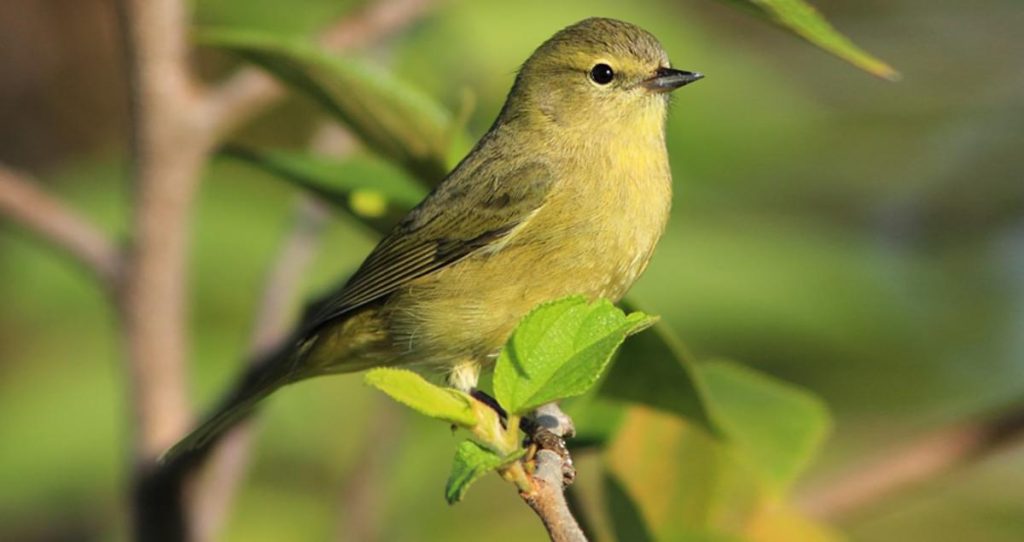
Orange-crowned Warblers can be observed in Alberta during the summer months, from mid-April to October, with their highest frequency during the fall migration, appearing in up to 15% of checklists during this time.
These warblers may not boast as vibrant colors as other species, displaying yellow-olive plumage, which appears more yellow along the Pacific Coast. Their orange crown is rarely visible.
Scientific Name: Leiothlypis celata
Length: 4.3-5.5 inches (11-14 cm)
Weight: 0.3-0.4 ounces (7-11 g)
Wingspan: 7.5 inches (19 cm)
Orange-crowned Warblers breed in Canada, western US states, and migrate to the Pacific, East and Gulf Coasts, and Mexico. They can also be observed during migration across all US states, except the northeastern region.
These warblers can be found in shrubs, low vegetation, and open woodlands. Their diet primarily consists of spiders, insects such as caterpillars and flies, as well as fruit, berries, and seeds. They are known to visit backyard feeders regularly.
9. Baltimore Oriole (Female)
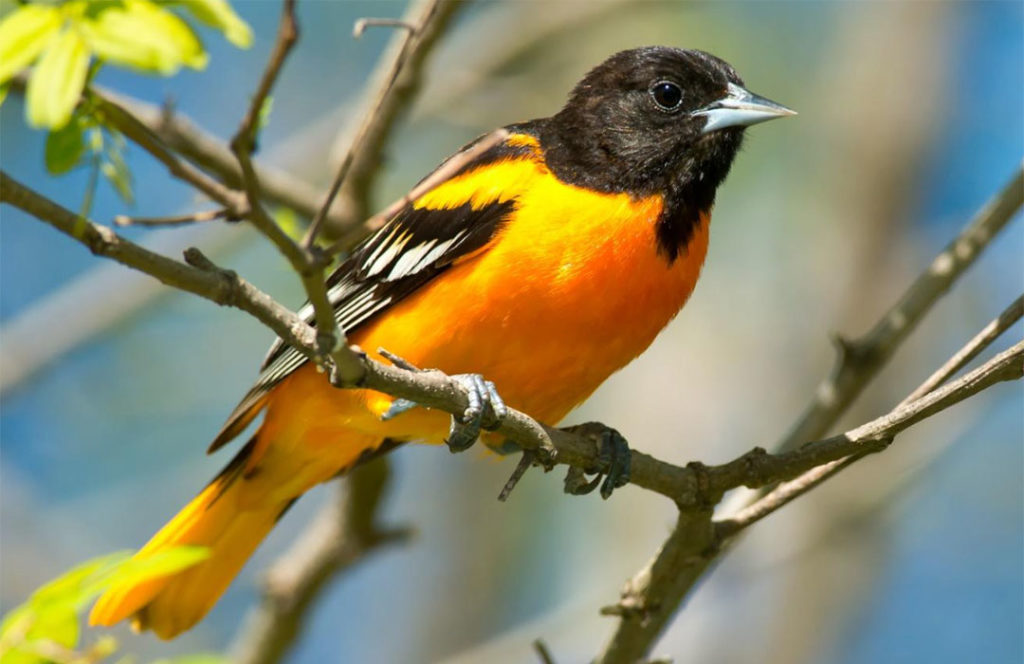
Baltimore Orioles can be sighted in Alberta during the summer, primarily from May to September, appearing in approximately 6% of checklists during this period.
These birds serve as a colorful sign of spring in the eastern regions of North America. Adult males exhibit bright orange and black plumage, adorned with white wing bars on their black wings.
Scientific Name: Icterus galbula
Length: 6.7-7.5 inches (17-19 cm)
Weight: 1.1-1.4 ounces (30-40 g)
Wingspan: 9.1-11.8 inches (23-30 cm)
Female Baltimore Orioles display yellowish tones on their undersides and heads, along with grayish-brown wings. They are similar in size to a Robin but possess a more slender build. Baltimore Orioles belong to the blackbird family.
Baltimore Orioles breed in eastern and central states, including central-southern Canadian provinces and along the US southern border. They migrate to Florida, Central America, and the Caribbean for the winter, departing as early as July.
These birds can be found in open woodlands, riverbanks, forest edges, and often visit parks and backyards. Their diet primarily consists of insects such as beetles, crickets, grasshoppers, spiders, and snails. They also consume a wide variety of fruits, although they can cause damage to crops such as raspberries, mulberries, cherries, bananas, and oranges.
10. Wilson’s Warbler
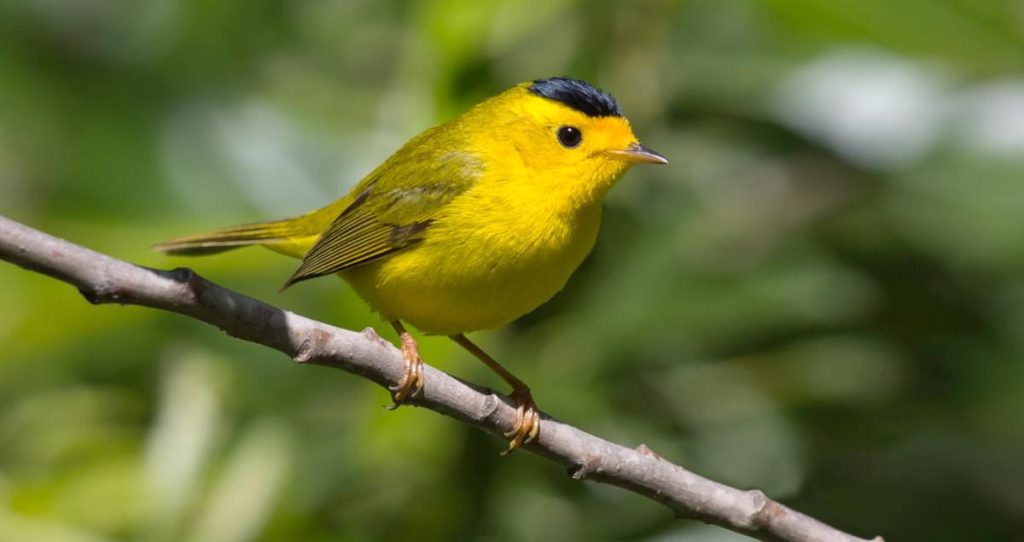
Wilson’s Warblers can be spotted in Alberta during the summer, from May to October, with their highest frequency during the fall migration, appearing in up to 20% of checklists during this time.
These tiny, round yellow warblers feature a large black cap in males and a smaller black cap in females.
Scientific Name: Cardellina pusilla
Length: 3.9-4.7 inches (10-12 cm)
Weight: 0.2-0.3 ounces (5-10 g)
Wingspan: 5.5-6.7 inches (14-17 cm)
Wilson’s Warblers breed in Canada, Alaska, and northwestern US states. During migration, they can be observed across all US states, excluding the northeastern region. They winter in Mexico and Central America.
These warblers can be found along streams, in thickets, and near forest edges, where they forage for insects, larvae, and spiders.
11. American Redstart

American Redstarts can be spotted in Alberta during the summer, primarily from May to September, and appear in approximately 9% of summer checklists.
These vibrant birds exhibit black plumage with striking orange patches on their wings, tail, and sides. Females and immature individuals display grayish tones with yellow accents.
Scientific Name: Setophaga ruticilla
Length: 4.3-5.1 inches (11-13 cm)
Weight: 0.3-0.4 ounces (8-11 g)
Wingspan: 6.3-7.9 inches (16-20 cm)
American Redstarts breed in eastern and central North America, as well as parts of Canada, and migrate to wintering grounds in Mexico, Central America, and the Caribbean.
These birds can be found in various habitats, including forests, woodland edges, and shrubby areas near water bodies. They are known for their active foraging behavior, capturing insects on the wing.
12. Western Tanager

Western Tanagers can be observed in Alberta during the summer, from May to September, and are present in approximately 8% of summer checklists.
These striking birds showcase a vibrant combination of bright yellow plumage on their undersides and black plumage on their backs, wings, and heads. Males possess a distinctive orange-red face, while females display a more subdued yellow-green coloring.
Scientific Name: Piranga ludoviciana
Length: 6.3-7.5 inches (16-19 cm)
Weight: 0.8-1.2 ounces (24-34 g)
Wingspan: 9.8-11.8 inches (25-30 cm)
Western Tanagers breed in western North America and parts of Canada, migrating to wintering grounds in Mexico and Central America.
These birds can be found in coniferous and mixed forests, as well as open woodlands. They primarily feed on insects, foraging among foliage and branches.
13. Western Kingbird

Western Kingbirds can be sighted in Alberta during the summer, from May to September, and appear in approximately 5% of summer checklists.
These medium-sized birds display a combination of grayish-brown upperparts and bright yellow undersides. They possess a distinctive white or pale yellow band on their tails.
Scientific Name: Tyrannus verticalis
Length: 7.5-8.7 inches (19-22 cm)
Weight: 1.0-1.5 ounces (28-43 g)
Wingspan: 15.0-16.1 inches (38-41 cm)
Western Kingbirds breed across western North America and parts of Canada, migrating to wintering grounds in Mexico and Central America.
These birds can be found in open habitats, such as grasslands, farmlands, and open woodlands. They primarily feed on insects, capturing them in aerial pursuits.
14. Magnolia Warbler
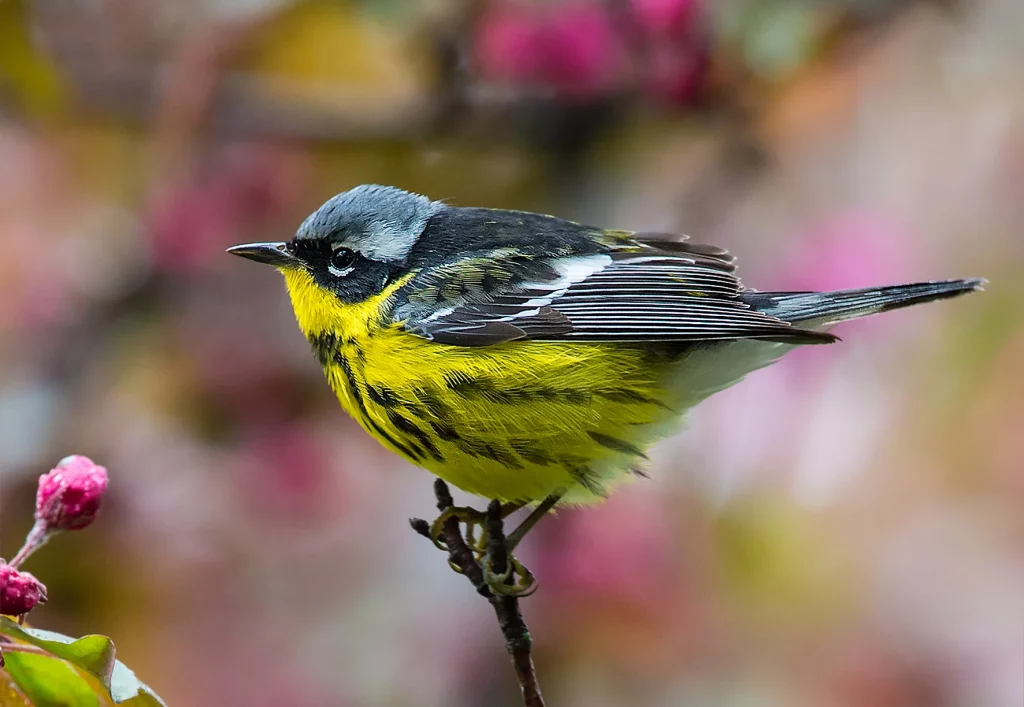
Magnolia Warblers can be spotted in Alberta during the summer, from May to September, and appear in approximately 7% of summer checklists.
These small warblers exhibit a unique combination of bright yellow plumage on their undersides, dark gray upperparts, and a black necklace-like pattern across their chests.
Scientific Name: Setophaga magnolia
Length: 4.3-5.1 inches (11-13 cm)
Weight: 0.3-0.4 ounces (9-11 g)
Wingspan: 7.5-8.7 inches (19-22 cm)
Magnolia Warblers breed in the boreal forests of Canada and parts of the northeastern United States, migrating to wintering grounds in Central and South America.
These birds can be found in various forest habitats, foraging for insects among tree branches and foliage.
15. Canada Warbler
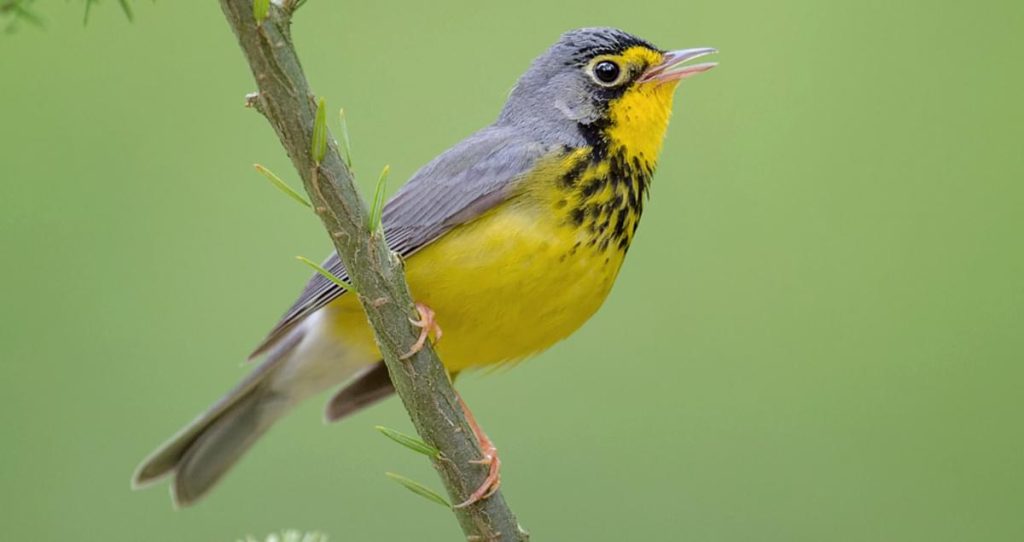
Canada Warblers can be observed in Alberta during the summer, primarily from May to September, and appear in approximately 6% of summer checklists.
These small warblers showcase grayish-blue upperparts and vibrant yellow undersides. Males possess a distinctive necklace-like pattern across their chests.
Scientific Name: Cardellina canadensis
Length: 4.3-5.1 inches (11-13 cm)
Weight: 0.3-0.4 ounces (9-11 g)
Wingspan: 7.5-8.7 inches (19-22 cm)
Canada Warblers breed in the boreal forests of Canada and parts of the northeastern United States, migrating to wintering grounds in northern South America.
These birds can be found in moist deciduous and mixed forests, often foraging for insects in the lower understory and on the ground.
16. Palm Warbler

Palm Warblers can be spotted in Alberta during migration periods, primarily in the spring and fall, and appear in approximately 5% of checklists during these times.
These small warblers display brownish-olive upperparts, yellow undertail coverts, and a distinctive rusty cap during the breeding season.
Scientific Name: Setophaga palmarum
Length: 4.7-5.1 inches (12-13 cm)
Weight: 0.3-0.4 ounces (9-11 g)
Wingspan: 7.9-8.7 inches (20-22 cm)
Palm Warblers breed in the boreal forests of Canada and parts of Alaska, migrating to wintering grounds in the southeastern United States, the Caribbean, and Central America.
During migration, these birds can be found in a variety of habitats, including woodlands, thickets, and open areas, where they primarily feed on insects.
17. Cape May Warbler

Cape May Warblers can be observed in Alberta during migration periods, primarily in the spring and fall, and appear in approximately 4% of checklists during these times.
These small warblers exhibit a unique combination of yellow-green plumage, rusty-colored cheeks, and distinctive chestnut streaks on their chests.
Scientific Name: Setophaga tigrina
Length: 4.3-5.1 inches (11-13 cm)
Weight: 0.3-0.4 ounces (9-11 g)
Wingspan: 7.5-8.7 inches (19-22 cm)
Cape May Warblers breed in the boreal forests of Canada and parts of the northeastern United States, migrating to wintering grounds in the Caribbean and northern South America.
During migration, these birds can be found in various habitats, including forests, woodlands, and shrubby areas, where they primarily feed on insects.
18. Black-throated Green Warbler
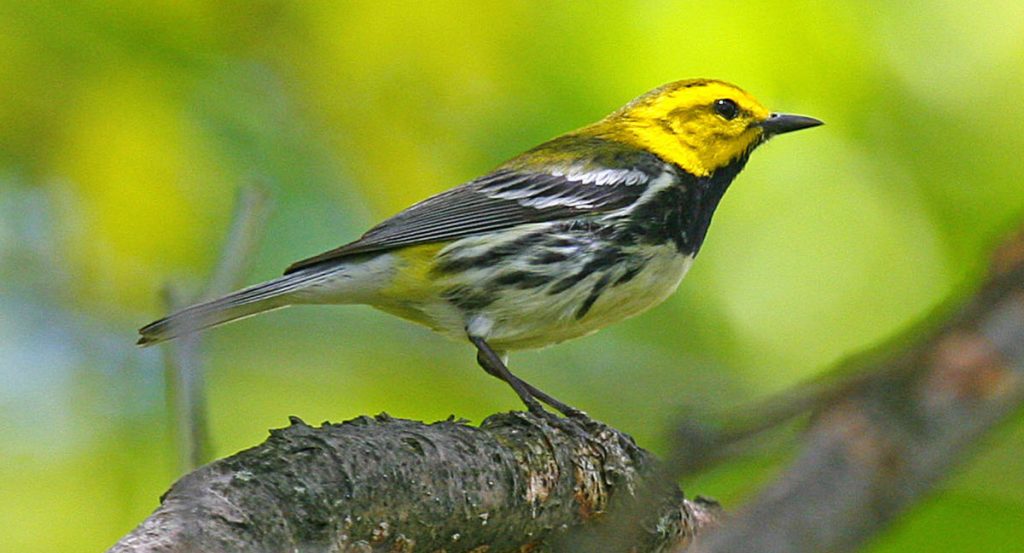
Black-throated Green Warblers can be observed in Alberta during migration periods, primarily in the spring and fall, and appear in approximately 4% of checklists during these times.
These small warblers showcase yellowish-green upperparts, a black throat, and yellow undertail coverts.
Scientific Name: Setophaga virens
Length: 4.7-5.1 inches (12-13 cm)
Weight: 0.3-0.4 ounces (9-11 g)
Wingspan: 7.5-8.7 inches (19-22 cm)
Black-throated Green Warblers breed in the boreal forests of Canada and parts of the northeastern United States, migrating to wintering grounds in the southeastern United States, the Caribbean, and
Central America.
During migration, these birds can be found in various habitats, including forests, woodlands, and shrubby areas, where they primarily feed on insects.
19. Evening Grosbeak
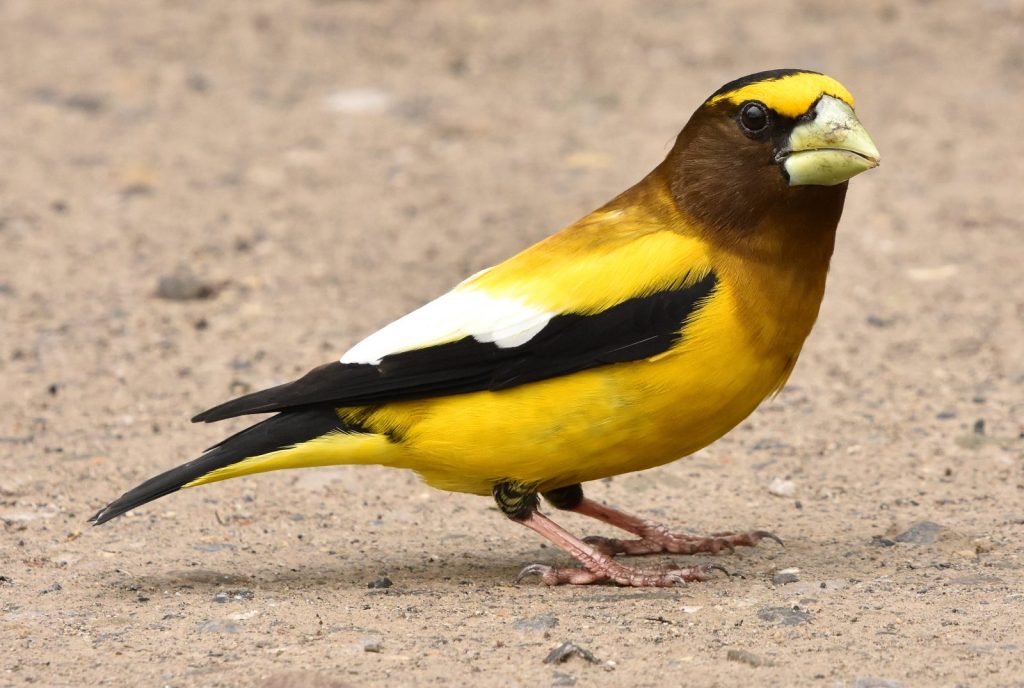
Evening Grosbeaks can be spotted in Alberta throughout the year, appearing in both summer and winter seasons.
These robust finches feature a unique combination of yellow plumage, black wings with white patches, and a large, thick beak.
Scientific Name: Coccothraustes vespertinus
Length: 7.1-8.7 inches (18-22 cm)
Weight: 1.8-2.6 ounces (51-74 g)
Wingspan: 13.4-15.8 inches (34-40 cm)
Evening Grosbeaks can be found in coniferous forests and open woodlands, where they primarily feed on seeds, fruits, and buds.
Fun Fact: Evening Grosbeaks are known for their distinct and melodious calls, which can often be heard in their woodland habitats.
These 19 species of yellow birds can be found in Alberta during various seasons, providing birdwatchers and nature enthusiasts with a diverse array of colorful and captivating sightings. Enjoy observing these beautiful avian residents and migrants in their natural habitats!